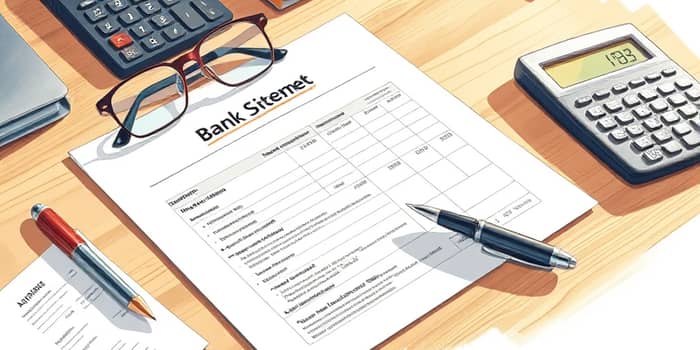
Reading a bank statement can feel overwhelming at first glance, with numbers, codes, and abbreviations all vying for your attention. But armed with the right approach and a clear understanding of each section, you can transform that monthly document into a powerful tool for financial confidence.
A monthly document summarizing account activity, the bank statement records all transactions within a specific period. Issued by your financial institution, it provides an overview of deposits, withdrawals, fees, and interest earned. By reviewing this document, you can track and review your financial transactions and stay informed about every change to your account.
Statements may arrive in paper form or as a PDF in your online banking portal. Regardless of the format, the core purpose remains the same: to help you verify your account activity, identify unexpected charges, and manage your budget effectively.
Statements typically arrive monthly, but some banks allow you to choose quarterly or customizable periods. Electronic delivery reduces paper clutter and speeds up access, while paper statements can serve as a physical record. Regardless of form, treating your statement with care protects against identity theft and unauthorized access.
Most statements follow a similar structure, divided into clear sections that outline your personal details, balance summaries, transaction history, and any fees or interest. A visual table can clarify how these elements fit together.
By scanning this layout, you gain a roadmap for detailed review, ensuring you know where to find each piece of information and how it affects your overall finances.
The account information section anchors the statement to you, ensuring it belongs to the correct individual and period. Always confirm the dates to avoid mixing transactions from different cycles.
In the balance summary, track changes from one period to the next—sharp drops in ending balance may signal overspending or unexpected fees. The average monthly balance offers insight into whether you maintain required minimums to avoid service charges.
Transaction details form the heart of the statement, listing each deposit and withdrawal. For checks, note the check number, payee, and posted date to ensure you’ve recorded everything accurately.
Beyond simple shorthand, banks may use codes for pending holds, decimal separators, or special footnotes. For example, “CTR” might denote currency transaction reporting, and “NSF” signals non-sufficient funds. Check your bank’s legend if you encounter unfamiliar notation.
With this cheat sheet, you’ll feel more at ease when you see strings of letters beside transaction amounts. Additionally, recognize balance figures as either “ledger” or “available.” The latter may exclude pending items and gives a real-time snapshot of spendable funds.
Understanding these terms helps you understand pending versus posted transactions and avoid misjudging your actual balance.
Begin by verifying personal information and statement dates. Any discrepancy could indicate an error in processing or a risk to your account’s security.
Move on to the account overview: compare the beginning balance to the ending balance to see net changes. If your sample statement shows a beginning balance of $527.63 and an ending balance of $321.88, it reflects total withdrawals exceeding deposits by $205.75.
Next, analyze the deposit and withdrawal breakdown. Large, unexpected withdrawals can highlight unauthorized activity. Small, recurring fees—like a $5.00 monthly maintenance charge—may seem minor individually but add up over time.
Scrutinize each transaction line. A purchase labeled “POS STORE 123” might mask the actual vendor name, so cross-check receipts. If a check with number 1006 doesn’t match your record of $25.15, investigate immediately to maintain financial accuracy and security.
Create a simple spreadsheet or use a budgeting app to reconcile each transaction. Categorize expenses into food, utilities, entertainment, and transfers to see spending patterns and identify areas for savings. Regular reconciliation fosters disciplined money habits and highlights trends over time.
Finally, take note of fees and interest. Interest-bearing accounts show an APYE and total interest paid—compare this against promotional offers or alternative accounts to ensure you’re getting the best return on your balance.
Using these practical tips ensures you can identify errors or fraud swiftly and take corrective action within the allowable dispute period.
Review your bank statement every month without fail. Set a calendar reminder or enable email notifications when your statement is ready. This habit helps you catch issues early, rather than letting them slip into next month’s review.
Store paper statements in a locked file or keep digital copies in an encrypted folder. Treat each statement as a confidential document, since it contains sensitive data like account numbers and social information.
If you prefer digital tools, many banks offer web dashboards with filters to sort transactions by date, type, or amount. Use alerts for low balances or large withdrawals to stay informed in real time.
Keep archived statements for at least one year for budgeting comparison, and up to seven years if needed for tax records or audits. Well-organized archives simplify end-of-year tax preparation and protect you in the event of an IRS inquiry or legal requirement.
Supplement your review with bank-provided resources—most institutions publish online glossaries and sample statements. These materials can clarify rare entries and deepen your familiarity with the statement format.
By understanding each section of your bank statement, you turn a complex financial report into a powerful tool for budgeting and security. With consistent review, seek clarification on unclear entries and compare transactions against your records to maintain peace of mind.
Over time, this practice builds confidence in your financial management, helping you achieve goals from saving for a vacation to planning long-term investments. Share these practices with family members or friends new to banking, helping them build strong financial foundations from the start.
References













